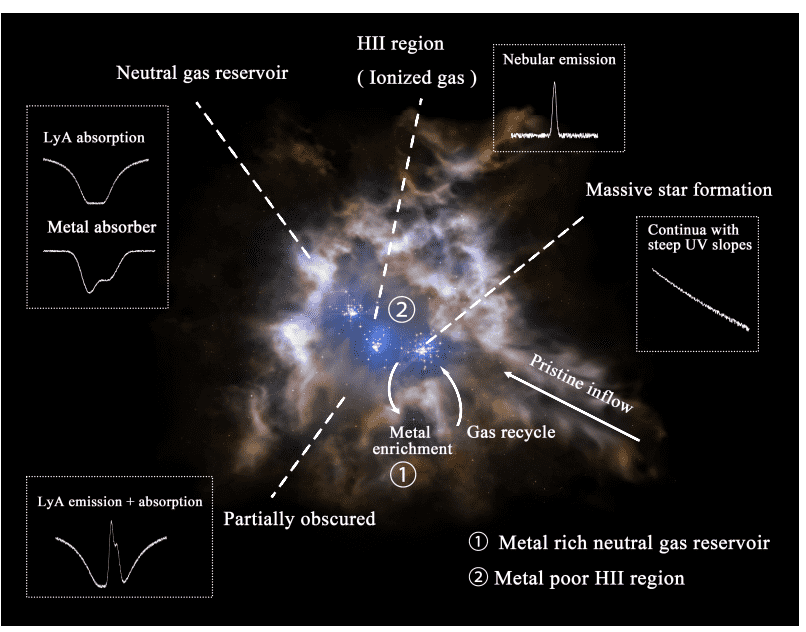I am currently a fifth-year Ph.D. student in the Department of Astronomy at Tsinghua University, where I study extragalactic astrophysics under the supervision of Prof. Zheng Cai. From 2023 to 2025, I was a visiting student at Steward Observatory in Tucson, Arizona, working with Prof. Xiaohui Fan and Dr. Eiichi Egami. Before beginning my graduate research, I took my first step into astronomy as an undergraduate in the PKU Pulsar Group at Peking University, studying pulsar physics with Prof. Renxin Xu and Prof. Kejia Li.
My research broadly spans the Universe, from galaxy evolution to black hole growth. I focus particularly on young black holes and galaxies, including: (1) The early growth and accretion of AGNs and black holes, including the enigmatic population recently discovered by JWST, nicknamed ‘‘Little Red Dots’’. (2) The evolution of young galaxies and their intrinsic and environmental properties, across both cosmological and small-scale perspectives. I study the Universe using multi-band data from a range of ground- and space-based telescopes, including SDSS, DESI, VLT, HST, and JWST.
I am actively involved in several collaborations, including SAPPHIRES, MAGNIF, CONGRESS, JADES, ASPIRE, COSMOS-3D, etc.
📖 Educations
- 2023.10 – 2025.06, Visiting student, Steward Observatory, Tucson, Arizona.
- Advisor: Prof. Xiaohui Fan & Dr. Eiichi Egami
- 2021.09 – Present, Ph.D. student in Astronomy, Tsinghua University, Beijing, China.
- Advisor: Prof. Zheng Cai
- 2017.09 – 2021.06, B.S. in Astronomy, Peking University, Beijing, China.
- Thesis: Probing Diffuse Lyman Alpha Emission on Cosmological Scales
- Advisor: Prof. Zheng Cai (Tsinghua University) & Prof. Zheng Zheng (University of Utah)
📝 Researches
Little Red Dots from the high-redshift to the Local Universe

“Little Red Dots” (LRDs) are a newly discovered population of AGNs first identified at (z > 4), notable for their V-shaped UV–optical continuum and prominent Balmer absorption. Their unusual features challenge our current understanding of early black hole growth. Using JWST wide-field slitless spectroscopy, we have identified numerous high-redshift LRDs (Lin+24b, Lin+25a), revealed their abundance, conducted a demographic study of their properties, and investigated their large-scale environments (Lin+25c).
The discovery of low-redshift LRDs provides a new window into their nature. We have identified three LRDs at $z \approx$0.1-0.2 (Lin+25d), and follow-up spectroscopy reveals exceptionally rich spectral details that are inaccessible in most high-redshift counterparts. Their striking characteristics, including extremely high-EW, cool-star–like absorption, cannot be explained by standard AGN models or stellar populations. These features reveal a cool gaseous envelope around the black holes, reminiscent of an atmosphere, inspiring a new paradigm for LRDs (left).
Young galaxies in the Early Universe

The launch of JWST has opened a new window into the early Universe, transforming our understanding of galaxy formation and evolution. Its wide-field slitless spectroscopy (WFSS) enables unbiased surveys of line-emitting galaxies, allowing us to study star formation, cosmic evolution, and the large-scale environments of $z>4$ galaxies with [O III] and Hα (Lin+25b).
By combining JWST with ground-based facilities like VLT/MUSE, we probe optical emission lines (e.g., [O III], Hα) and UV properties (e.g., Lyα), revealing the stellar populations and interstellar medium of early galaxies (Lin+23, Lin+24a). Together, these observations provide an unprecedented view of the physical conditions, growth, and environments of galaxies in the early universe, offering new insights into the dawn of galaxy formation. We lead a 72.7-hour JWST/NIRSpec program, DIVER, targeting the rest-frame UV of $z>5$ galaxies to uncover young stellar populations and their nucleosynthesis history.
📄 Publications
All papers on ADS Library.
First Author
- Lin, X., Fan, X., Cai, Z., et al. 2025, The Discovery of Little Red Dots in the Local Universe: Signatures of Cool Gas Envelopes, submitted
- Lin, X., Fan, X., Wang, F., et al. 2025, Bridging Quasars and Little Red Dots: Insights into Broad-Line AGNs at z=5-8 from the First JWST COSMOS-3D Dataset, submitted
- Lin, X., Fan, X., Sun, F., et al. 2025, The Large-scale Environments of Low-luminosity AGNs at 3.9 < z < 6 and Implications for Their Host Dark Matter Halos from a Complete NIRCam Grism Redshift Survey, submitted
- Lin, X., Egami, E., Sun, F., et al. 2025, The Luminosity Function and Clustering of Hα Emitting Galaxies at z≈4-6 from a Complete NIRCam Grism Redshift Survey, submitted
- Lin, X., Wang, F., Fan, X., et al. 2024, A Spectroscopic survey of biased halos In the Reionization Era (ASPIRE): Broad-line AGN at z=4-5 revealed by JWST/NIRCam WFSS, ApJS, 914, 147
- Lin, X., Cai, Z., Wu, Y., et al. 2024, Quantifying the escape of Lyα at z=5-6: a census of Lyα escape fraction with Hα emitting galaxies spectroscopically confirmed by JWST and VLT/MUSE, ApJS, 272, 33
- Lin, X., Cai, Z., Zou, S., et al. 2023, Metal-Enriched Neutral Gas Reservoir around a Strongly-lensed, Low-mass Galaxy at z=4 Identified by JWST/NIRISS and VLT/MUSE, ApJL, 944, 59
- Lin, X., Zheng, Z. & Cai, Z. 2022, Probing the Diffuse Lyα Emission on Cosmological Scales: Lyα Emission Intensity Mapping Using the Complete SDSS-IV eBOSS, ApJS, 262, 38
- Lin, X., Cai, Z., Li, Y., et al. 2020, Constraining the Halo Mass of Damped Lyman alpha Absorption Systems (DLAs) at z = 2-3.5 Using the Quasar–CMB Lensing Cross-correlation, ApJ, 905, 176
💻 Data and Codes
-
JWST/WFSS-selected Hα emitters in GOODS-S (from FRESCO) with Lyα measurements from VLT/MUSE (MUSE-WIDE, AMUSE) and Lyα escape fractions. See Lin et al. 2024 for details. Access the data on GitHub or Zenodo.
-
Semi-automated algorithm for determining spectroscopic redshifts of large JWST/WFSS-selected emitter samples. See Lin et al. 2025 for details. Coming soon.
